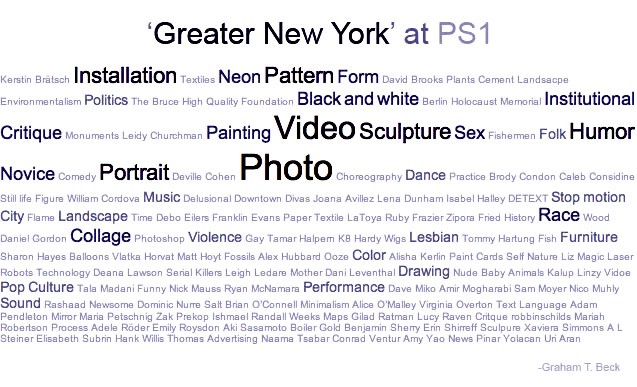‘Greater New York’ by the Numbers
‘Greater New York’ by the Numbers
by Graham T. Beck
In order to really remember anything about an exhibition as big as ‘Greater New York’, you have to forget a lot of it. Though this third iteration of PS1’s quinquennial survey is smaller than ever before, it still features 68 up-and-coming New Yorkers spread over four floors. To write a review of all that, you have to forget even more. Attention spans can’t accommodate that many artists nor that much art, and neither can word counts or column inches or casual readers.
For museum visitors this means walking away from big surveys with a few works in mind, maybe an artist’s name, and a general impression: Dude, there’s a ton of dance.
For the readers of reviews it means a few details about a handful of artists, one long list of themes, and a briefly reasoned conjecture about the medium of the moment. The Times said performance art; New York Magazine went with collage; the Village Voice claimed it was video and installation.
They’re all wrong.
Instead of reviewing this year’s ‘Greater New York,’ I made a spreadsheet that listed every artist alphabetically with columns for medium used, major features and pronounced themes. As I went through the show I made notes in each of the resulting cells. Some of the contributors ended up with a few words in each, while others didn’t have any. The resulting tag cloud, though not scientifically perfect, has a much better memory and a less biased recall than your average review.

As you can see, once again, it was photography that dominated the show-followed by video and sculpture, and installation, with drawing and painting and collage bringing up the rear, as it were. Notable themes included “portraiture,” “humor,” “sex,” “race,” “violence”-and “lesbians.” Down low: “plants” and “the city.” And “serial killers.”
Maybe you find this sort of thing interesting. Maybe I can carve out a lucrative art-statistics niche? Maybe Nate Silver wants to dust off his TI-82 and battle me in Drugwars?
Graham T. Beck writes about art, cities, the environment and his problems.
